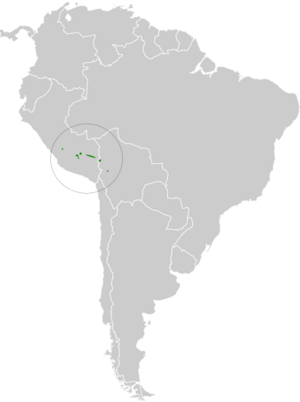Royal cinclodes facts for kids
Quick facts for kids Royal cinclodes |
|
|---|---|
 |
|
| Conservation status | |
| Scientific classification | |
| Genus: |
Cinclodes
|
| Species: |
aricomae
|
 |
|
The royal cinclodes (Cinclodes aricomae) is a special type of bird found in Bolivia and Peru. It belongs to a group of birds called passerines, which are often called "perching birds." This means they have feet made for gripping branches. The royal cinclodes is part of the ovenbird family called Furnariidae. Sadly, this bird is Critically Endangered, meaning it's at a very high risk of disappearing forever.
Contents
What Does the Royal Cinclodes Look Like?
The royal cinclodes is a fairly large bird, about 20 to 21 cm (8 inches) long. It weighs around 50 grams (1.8 ounces), which is about the same as a small apple. Both male and female royal cinclodes look alike.
Special Features of the Royal Cinclodes
This bird has a bill that curves downwards and is thick at its base. It has a pale, yellowish-white stripe above its eye, called a supercilium, which goes all the way to the back of its neck. Its cheeks are whitish with thin dark lines. The rest of its face and its upper body are dark brown.
Wings and Tail
The wings of the royal cinclodes are also dark brown. They have a reddish-brown band with black edges across the base of their flight feathers. Their tail is a dark, blackish color.
Underparts and Other Details
The bird's throat is whitish with thin dark lines. Its belly and chest are dark brown, but its chest has wide white streaks. The royal cinclodes has dark brown eyes and a black bill. Its legs and feet can be dark pinkish-gray or black.
Where Does the Royal Cinclodes Live?
The royal cinclodes lives in specific areas of Peru and Bolivia. In Peru, you can find it in the departments of Junín, Apurímac, Cuzco, and Puno. It also lives in the La Paz Department in Bolivia.
Royal Cinclodes Habitat
This bird prefers to live in damp forests with Polylepis and Gynoxys trees. It especially likes wet, marshy areas at the bottom of steep, rocky hills. You can find the royal cinclodes at very high elevations, from about 3,500 to 4,600 meters (11,500 to 15,000 feet) above sea level.
How Does the Royal Cinclodes Behave?
The royal cinclodes stays in the same area all year round. It does not migrate to different places.
What Does the Royal Cinclodes Eat?
The royal cinclodes mainly eats small creatures without backbones, like insects. Sometimes, it also eats seeds and small animals with backbones, such as frogs. It usually searches for food alone or with a partner. It probes and digs for its prey among mossy rocks, in rotting wood, and in wet, boggy ground. Sometimes, it also picks food off surfaces.
Reproduction and Life Cycle
Scientists believe the royal cinclodes' breeding season starts in December. Only one nest has been found so far. It was in a hole behind a crack in a cliff. This nest held two baby birds, and both parents helped feed them. Not much else is known about how these birds raise their young.
Vocalizations: What Does It Sound Like?
The song of the royal cinclodes is described as a "very loud trill."
Why Is the Royal Cinclodes Critically Endangered?
The IUCN (International Union for Conservation of Nature) first listed the royal cinclodes as "Threatened" in 1988. But since 1994, it has been listed as "Critically Endangered." This means it faces an extremely high risk of becoming extinct in the wild.
Population and Threats
There are very few royal cinclodes left. Scientists estimate there are only between 50 and 250 adult birds remaining. Their numbers are also believed to be going down. The main problems for these birds are:
- Uncontrolled fires: Fires destroy their habitat.
- Heavy grazing: Too many animals eating plants in their habitat damages the moss cover and stops new Polylepis trees from growing.
- Cutting down trees: People cut down trees for wood, firewood, and charcoal, which destroys the forests where these birds live.
Even though some areas where they live are supposed to be protected, they are still affected by grazing and burning. Climate change might also be a threat to these birds in the future.


